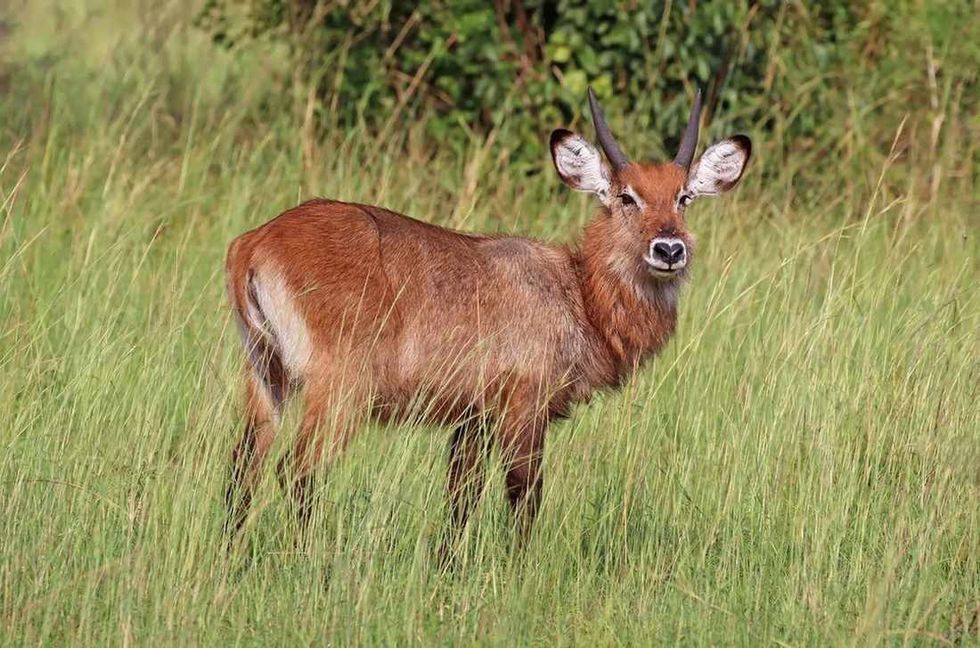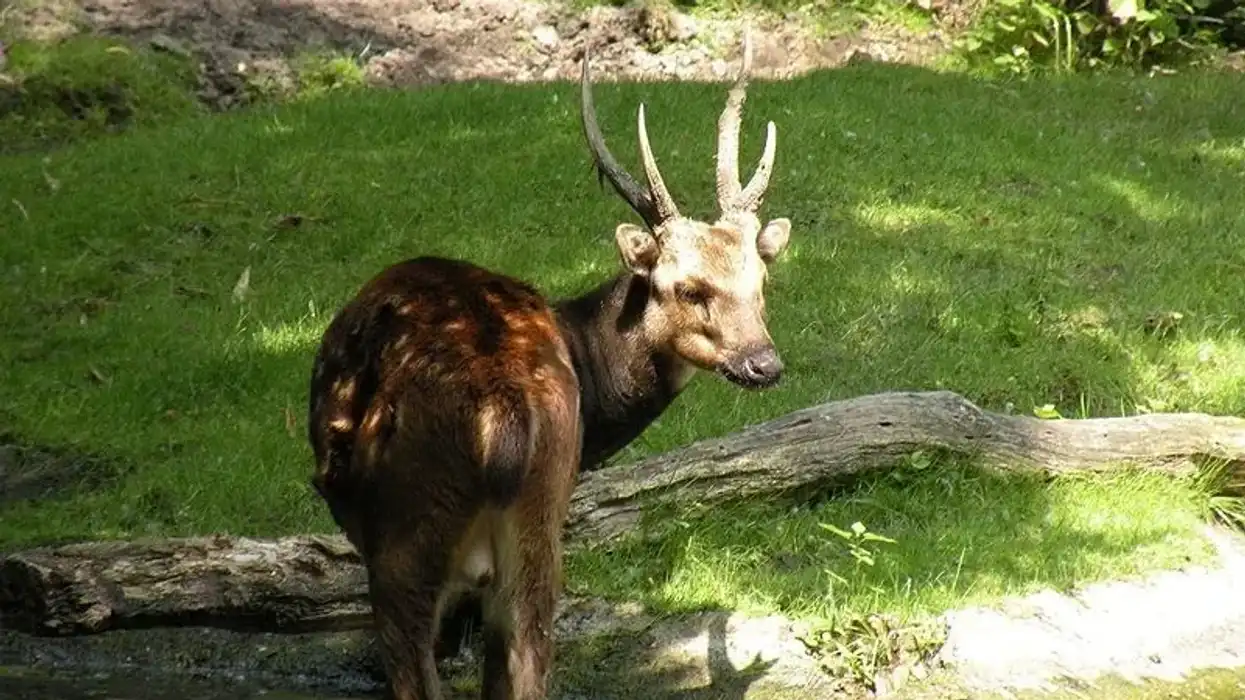The waterbuck antelope is a type of antelope found in the sub-Saharan region of the African continent. There are thirteen subspecies of African waterbuck, and they are subdivided into two varieties; the common, or Ellipsiprymnus, waterbuck, and the Defassa waterbuck.
The males have spiral horns that are long and curve backward and forward. They are social animals and form herds of 6 to 30 individuals.
The herds are made up of mothers and babies or bachelor herds. They lead a sedentary life with very little migration. The waterbuck will always stay close to a source of water as it cannot tolerate dehydration.
They will inhabit savanna or scrubland near a river, lakes, or valleys. The waterbuck is the largest species among the six species of Kobus.
The males and females look alike. They are well-built creatures with a shaggy coat that is reddish-brown to gray, which becomes darker with age.
They have long and shaggy hair on their necks in comparison to the rest of their body, which appears thick but sparse. They have a white muzzle with light eyebrows and lighter color inside their ears.
They have a cream-colored patch on their throat, with a long neck and strong, short black legs. The defassa waterbucks are completely different in looks as compared to common waterbucks.
African savanna and tropical forests are the native habitats of these animals. You can tell the age of a male by analyzing their horns.
The skulls of the female also have a rudimentary lump or bump on their head, which grows into horns in the male but not in the female waterbuck. After reading these interesting facts on waterbucks, do check out the spiral-horned antelope and the impala.
Waterbuck Interesting Facts
What type of animal is a waterbuck?
A waterbuck (Kobus ellipsiprymnus) is a type of antelope found in the sub-Saharan region of Africa. It is a compact animal with horns and a shaggy brownish-red to gray-colored coat. The distinct white ring present around the hindquarters of the waterbuck is essentially a 'follow me' sign for predators.
What class of animal does a waterbuck belong to?
The waterbuck belongs to the class Mammalia of animals as they give birth to one offspring like many other mammals. It is a gregarious animal found in herds in the savanna or shrublands of the sub-Saharan desert.
How many waterbucks are there in the world?
The population of waterbucks is around 200,000. There are growing concerns about the decreasing population due to poaching and human disturbance in their region. The population is decreasing in Lake Nakuru National Park due to heavy metal poisoning.
Where does a waterbuck live?
The ellipsiprymnus waterbuck is found in the southeast African region and the defassa waterbuck is found in the central, northeastern, and western African regions.
In eastern and southern Africa, they are found in Botswana, Angola, Ethiopia, the Democratic Republic of Congo, Namibia, Kenya, Tanzania, Uganda, and South Africa. In the northern and western regions of Africa, they are found in countries like Cote d’Ívoire, Chad, Mali, Ghana, Nigeria, Niger, and Senegal.
These animals live in small herds ranging from five to 10 members, while the young males form bachelor herds when their horns start to emerge.
What is a waterbuck's habitat?
The common waterbuck is found in savanna, scrub, or riverine forests alongside lakes, rivers, and valleys. They prefer to live beside the draining lines.
This species is native to South Africa and its habitat is primarily located in the northern parts of the country. This species likes living on dry land but it will always be close to a water resource for food, water, and escape from predators.
Waterbuck grazing during the night has become a common phenomenon due to habitat loss from human activities.
Who do waterbucks live with?
Common waterbucks are social animals and form a group of up to 30 individuals. The groups are made up of mothers and babies, or bachelor herds.
The females may also roam alone or in pairs in overlapping ranges resulting in forming smaller herds of between five and 10 individuals. Once the horns begin to form in the young males, they will separate from the mixed groups and form their tight groups.
How long does a waterbuck live?
Their lifespan is around 18 to 30 years. It may be shorter in the wild.
How do they reproduce?
The female matures at the age of three years and the male matures at the age of six years. In the regions closer to the equator, the breeding is all year round.
The breeding process begins only after the male confirms that the female is in her oestrus by smelling her vulva and urine. If a female is not interested, she will resist or bite the approaching males.
The males are observed to do the flehmen's behavior, or lick the female’s neck and rub his face along with the base of his horn on her back. There could be several attempts of mounting before copulation.
When the creature is sexually excited, the skin will secret a greasy substance that smells like musk. The odor is unpleasant and it helps in repelling its predators too.
These secretions help in making their skin waterproof when they dive into the water. They are called greasy jobs due to this.
In North Africa, a calf is born annually. The gestation period is 8 to 8.5 months. Most births take place during the rainy season. The mothers will walk away from their groups a few days before giving birth to a single calf.
After its birth, the baby can stand on its feet for half an hour. Still, the mother will keep the baby hidden in thickets for two to four weeks. The babies mature slower than other antelopes.
What is their conservation status?
The conservation status of the common waterbuck is of the least concern. There are growing concerns about the decreasing population of waterbuck (Kobus ellipsiprymnus) due to poaching and human disturbance in their region.
However, the defassa waterbuck are near threatened due to poaching and habitat loss. Hence concerted efforts are required for ensuring the conservation of common waterbuck and the defassa waterbuck species in the long run.
Waterbuck Fun Facts
What do waterbucks look like?

The male and females in the common waterbuck species look alike. Like antelopes, waterbucks are well-built creatures with a shaggy coat that is reddish-brown to grey, which becomes darker with age.
They have long and shaggy hair on their necks in comparison to the rest of their body where it appears thick but is sparse. They have a white muzzle with light eyebrows and lighter color inside their ears.
They have a cream-colored patch on their throat, with a long neck and strong, short black legs. The distinct white patch on the rump is interpreted as follow me a sign by fellow members of the herd.
The defassa waterbucks are completely different in looks as compared to the common waterbuck. The males have spiral horns that are long and curve backward and forward.
How cute are they?
They are cute and different-looking antelopes with an interesting pattern of horns. They can be found grazing around the shrublands of sub-Saharan Africa. Their solid white ring-shaped patches on each side of the rump are unique and add to their overall appearance.
How do they communicate?
The waterbuck does not have much vocal communication. They may use their sense of smell to communicate more. The mother waterbuck will communicate with her baby by bleating or snorting. During the mating period, the males may sniff a female who is ready to mate.
How big is the waterbuck?
The waterbuck is the largest species among the six species of Kobus. They are robust animals with muscular bodies. Their length is 5.80-7.73 ft, and their height is 3.93-4.43 ft.
How fast can a waterbuck run?
The waterbuck can run at a speed of around 32 mph. They are quick animals who also secrete a greasy substance from their skin which is foul-smelling and protects them from attacks.
How much does a waterbuck weigh?
Waterbucks weigh around 354-575 lb. They are compact muscular animals with strong short legs.
What are the male and female names of the species?
The male waterbucks are called bucks and the female waterbucks are called does. Their group is called a herd.
What would you call a baby waterbuck?
A baby waterbuck is called a calf.
What do they eat?
The waterbuck antelopes are majorly dependent on water and can't survive if dehydrated. Therefore they will always live close to water sources. Their diet comprises grass that is short to medium in length. They eat a very protein-rich diet. They will eat rushes and reeds too.
Are they dangerous?
Waterbucks are not dangerous to humans in any way until and unless they are disturbed or injured. Humans have been hunting and poaching these creatures for their horns, which is detrimental to their population. Males could be territorial and aggressive while defending their herd or territory from other males.
Would they make a good pet?
They are quiet animals who need water more than any other antelope. They can make good pets if we keep them in their natural habitat. Saving their region from human encroachment is an important task that needs to be done to conserve them.
Did you know...
The meat of the older waterbuck has a strange smell due to its secretion from its sweat glands.
The feeding pattern of waterbucks depends on their sex, age, distance from a water source, and season.
They may be active during both the day and night.
What do waterbucks use their horns for?
The males are territorial and start showing dominating behavior. Males prefer to stay in their territory. The fights between males can last for thirty minutes and involve snoring and using their horns to fight and defend territory. The fights may get bloody and cause deaths too.
What do mother waterbucks do after giving birth?
As a protective instinct, the mothers will often eat the afterbirth to avoid attracting predators. They will keep the baby waterbuck hidden for two to four weeks so that they can grow stronger.
Here at Kidadl, we have carefully created lots of interesting family-friendly animal facts for everyone to discover! Learn more about some other mammals including the scimitar oryx and the plains zebra.
You can even occupy yourself at home by drawing one of our Waterbuck coloring pages.










